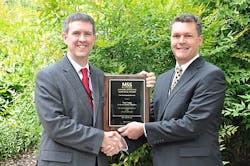Northrop Grumman's Paul D. Lang wins service award in infrared countermeasures
Rolling Meadows, IL--Northrop Grumman's Paul D. Lang, director of the company's Common Infrared Countermeasures (CIRCM) program, has received the 2012 Goodell-Pollock Memorial Award for Distinguished Service in recognition of his noteworthy contributions to the infrared countermeasures (IRCM) field.
The award, which is granted by the Military Sensing Symposium IRCM Committee, is given annually during the Military Sensing Symposium to recognize many years of outstanding service to the field.
During his 28 years of IRCM work, Lang has become an internationally recognized expert in the field. He holds three patents, has written 11 published technical papers on IRCM technology, and has worked on nearly every major IRCM program at Northrop Grumman.
As CIRCM program director, Lang directs all of Northrop Grumman's efforts to deliver and support CIRCM systems for the Army. He also has responsibility for all IRCM rotary wing programs at the company.
Lang joined Northrop Grumman in 1984 after receiving his master's degree in physics at the University of Illinois at Urbana-Champaign. His first job was in the company's Electro-Optical/Infrared (EO/IR) Advanced Technology Group developing advanced laser warning receivers, exploiting infrared missiles, and developing optical sources for IRCM systems.
In 1990, he joined the Directional Infrared Countermeasures (DIRCM) program contracted by the United Kingdom's Ministry of Defence. His work included measuring the infrared signatures for 13 types of UK aircraft, developing imager specifications, developing a new approach to triggering missile warning receivers, and managing DIRCM live fire events.
Lang became chief engineer on the Large Aircraft Infrared Countermeasures (LAIRCM) program in 2000. In this role, he oversaw the insertion of the Viper laser into the DIRCM transmitter, improved the AAR-54 missile warning receiver, and helped accelerate LAIRCM deployment for installation on the C-17 aircraft to meet urgent warfighter needs.
In 2008, Lang took on a new role developing lighter, more affordable IRCM systems designed for rotary-wing aircraft. His vast experience across the IRCM spectrum is one reason Northrop Grumman IRCM systems are installed today on more than 50 different types of aircraft.
-----
Follow Laser Focus World on your iPhone or Android
Subscribe now to Laser Focus World magazine; it's free!
